Economics Principles and Practices © 2012 GeorgiaChapter 8:
Employment, Labor, and WagesChapter OverviewsSection 1: The Labor Movement
A description is given of the growth of the labor movement from its roots in craft unions to industrial unions. Organized labor was generally unpopular until the Great Depression, but labor made great strides during the 1930s and did not lose public favor again until after the end of World War II when the Taft-Hartley Act was passed in 1947. During early development of unions, the two main types of unions were the craft or trade union and the industrial union, and their actions consisted of striking, picketing, and boycotting. In today’s society, the union arrangements consist of closed shop, union shop, modified union shop, and agency shop. Section 2: Wages and Labor Disputes
Different occupations and levels of training are rewarded with different wages. Economists divide labor into four non-competing labor grades based on a worker's education, training, and skills. These categories include unskilled labor, semiskilled labor, skilled labor, and professional labor. In addition, there are many negotiation methods to resolve labor disputes: collective bargaining, mediation, arbitration, fact-finding, injunction, and seizure. Finally, the president may intervene in a labor-management dispute. Section 3: Employment Trends and Issues
There are several employment trends and issues in today's economy. The first is the continuing decline of union membership and influence since the end of World War II. The second is the income gap between men and women, and policies such as set-aside contracts, which are designed to remedy it. The last is the issue of the minimum wage, which is measured in current dollars, inflation-adjusted dollars, and as a percent of the average manufacturing wage.  | 






